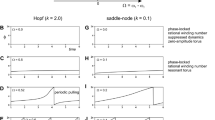Abstract
A mathematical model for the excitation-contraction coupling within a functional unit (locus) of the small bowel is proposed. The model assumes that: the functional unit is an electromyogenic syncytium; its electrical activity is defined by kinetics of L- and T-type Ca2+-channels, mixed Ca2+-dependent K+-channels, potential-sensitive K+-channels and Cl−-channels; the basic neural circuit, represented by the cholinergic and adrenergic neurones, provides a regulatory input to the functional unit via receptor-linked L-type Ca2+-channels; the smooth muscle syncytium of the locus is a null-dimensional contractile system. With the proposed model the dynamics of active force generation is determined entirely by the concentration of cytosolic calcium. The model describes electrical processes of the propagation of excitation along the neural circuit, chemical mechanisms of nerve-pulse transmission at the synaptic zones and the dynamics of active force generation. Numerical simulations have shown that it is capable of displaying different electrical patterns and mechanical responses of the locus. The simulated effects of: tetrodotoxin, β-bungarotoxin, salts of divalent cations, inhibitors of catechol-O-methyltransferase and neuronal uptake mechanisms, and changes in the concentration of external Ca2+ on the dynamics of force generation have been analysed. The results are in good qualitative and quantitative agreement with results of experiments conducted on the visceral smooth muscle of the small bowel.
Similar content being viewed by others
References
Arner A (1982) Mechanical characteristics of chemically skinned guinea-pig taenia coli. Pfluger's Arch 395:277–284.
Bertuzzi A, Mancinelli R, Ronzoni G, Salinari S (1978) A mathematical model of intestinal motor activity. J Biomech 11:41–47.
Bertuzzi A, Mancinelli R, Ronzoni G, Salinari S (1979) An analysis of the peristaltic reflex. Biol Cybern 35:205–221.
Bortoff A, Muller R (1975) Stimulation of intestinal smooth muscle by atropine, procaine and tetrodotoxin. Am J Physiol 1609–1613.
Cauvin C, Loutzenhiser R, Bremen C van (1983) Mechanisms of calcium antagonist-induced vasodilatation. Annu Rev Pharmacol Toxicol 23:373–396.
Crist JR, He XD, Goyal RK (1992) Both ATP and the peptide VIP are inhibitory neurotransmitters in guinea-pig ileum circular muscle. J Physiol (Lond) 447:119–131.
De Pedro MJ, Plaza MA, Arruebo MP, Murillo MD (1993) Effect of calcium antagonists on acetylcholine-induced contractions in longitudinal smooth muscle strips from sheep duodenum. J Gastrointest Mot 5:17–22.
Fay F, Williams DA (1987) Excitation-contraction coupling in single isolated smooth muscle cells. In: Szurszewski JH (ed) Cellular physiology and clinical studies of gastrointestinal smooth muscle. Elsevier, Amsterdam, pp 139–146.
Fox DA, Bass P (1986) Ablation of the myenteric plexus impairs alpha but not beta adrenergic receptor-mediated mechanical responses of rat jejunal longitudinal muscle. J Pharmacol Exp Ther 239:9–14.
Godfraind T, Morel N, Salomone S, Wibo M (1989) Tissue selectivity of calcium antagonists: pharmacological aspects. In: Christen MO, Godfraind T, McCallum RW (eds) Calcium antagonism in gastrointestinal motility. Elsevier, Amsterdam, pp 117–139.
Hartshorne DJ (1987) Biochemistry of the contractile process in smooth muscle. In: Johnson LR (ed) Physiology of the gastrointestinal tract. Raven Press, New York, pp 423–482.
Ito Y, Kuriyama H, Parker I (1988) Calcium transients by electrical stimulation of smooth muscle from guinea-pig ileum recorded by the use of Fura-2. J Physiol (Lond) 407:117–134.
Karaki H, Weiss GB (1988) Calcium release in smooth muscle. Life Sci 42:111–122.
Makhlouf GM (1987) Isolated smooth muscle cells of the gut. In: Johnson LR (ed) Physiology of the gastrointestinal tract. Raven Press, New York, pp 555–569.
Mandrek K, Golenhofen K (1990) Phasic-rhythmical and tonic components in gastrointestinal motility. In: Frontiers in Smooth Muscle Research, Alan R. Liss, Inc, pp 463–481.
Miftakhov RN, Wingate DL (1993) Modelling of the enteric nervous network. 2. Facilitation and inhibition of cholinergic transmission. J Med Phys Eng 16:311–319.
Miftakhov RN, Wingate DL (1994) Numerical simulation of the peristaltic reflex of the small bowel. Biorheology 31:309–325.
Miftakhov RN, Wingate DL (1995a) Modelling of the enteric nervous network. 4. Analysis of adrenergic transmission. J Med Phys Eng 17:3–10.
Miftakhov RN, Wingate DL (1995b) Modelling of the enteric nervous network. 5. Excitation propagation in a planar neural network. J Med Phys Eng 17:11–19.
Miftakhov RN, Abdusheva GR, Wingate DL (1996) Model predictions of myoelectrical activity of the small bowel. Biol Cybern (in press).
Morgan KG, Jiang MI (1987) Measurement of cytoplasmic Ca2+ during tonic and phasic contractions of mammalian smooth muscle. In: Szurszewski JH (ed) Cellular physiology and clinical studies of gastrointestinal smooth muscle. Elsevier, Amsterdam, pp 109–123.
Osinski MA, Bass P (1994) Increased active stress generation of denervated rat intestinal smooth muscle: functional analysis of muscarinic receptor population. J Pharmacol Exp Ther 268:1368–1373.
Ozaki H, Gerthoffer WT, Publicover NG, Fusetani N, Sanders KM (1991) Time-dependent changes in Ca2+ sensitivity during phasic contraction of canine antral smooth muscle. J Physiol (Lond) 440:207–224.
Prosser CL (1984) Smooth muscle. Annu Rev Physiol 36:503–535.
Sanders KM (1983) Excitation-contraction coupling without Ca2+ action potentials in small intestine. Am J Physiol 244:C356-C361.
Shulze-Delrieu K, Brown BP, Custer-Hagen T (1991) Contraction and accommodation of guinea-pig duodenum in vitro. Am J Physiol 24:G364-G372.
Somlyo AP, Himpens B (1989) Cell calcium and its regulation in smoth muscle. FASEB J 3:2266–2276.
Somlyo AP, Somlyo AV, Shuman H, Endo M (1982) Calcium and monovalent ions in smooth muscle. Fed Proc 41:2883–2890.
Waterman SA, Costa M (1994) The role of enteric inhibitory motoneurons in peristalsis in the isolated guinea-pig small intestine. J Physiol (Lond) 477:459–469.
Waterman SA, Costa M, Tonini M (1994) Enteric inhibitory reflexes mediate accommodation in isolated guinea-pig small intestine. J Physiol (Lond) 474:539–546.
Weems WA, Weisbrodt NW (1986) Ileal and colonic propulsive behavior: contribution of enteric neural circuits. Am J Physiol 250:G653-G659.
Westerblad H, Allen DG (1994) The role of sarcoplasmic reticulum in relaxation of mouse muscle: effects of 2,5-di(tert-butyl)-1,4-benzohydroquinone, J Physiol (Lond) 474:291–301.
Author information
Authors and Affiliations
Rights and permissions
About this article
Cite this article
Miftakhov, R.N., Abdusheva, G.R. Numerical simulation of excitation-contraction coupling in a locus of the small bowel. Biol. Cybern. 74, 455–467 (1996). https://doi.org/10.1007/BF00206712
Received:
Accepted:
Issue Date:
DOI: https://doi.org/10.1007/BF00206712




